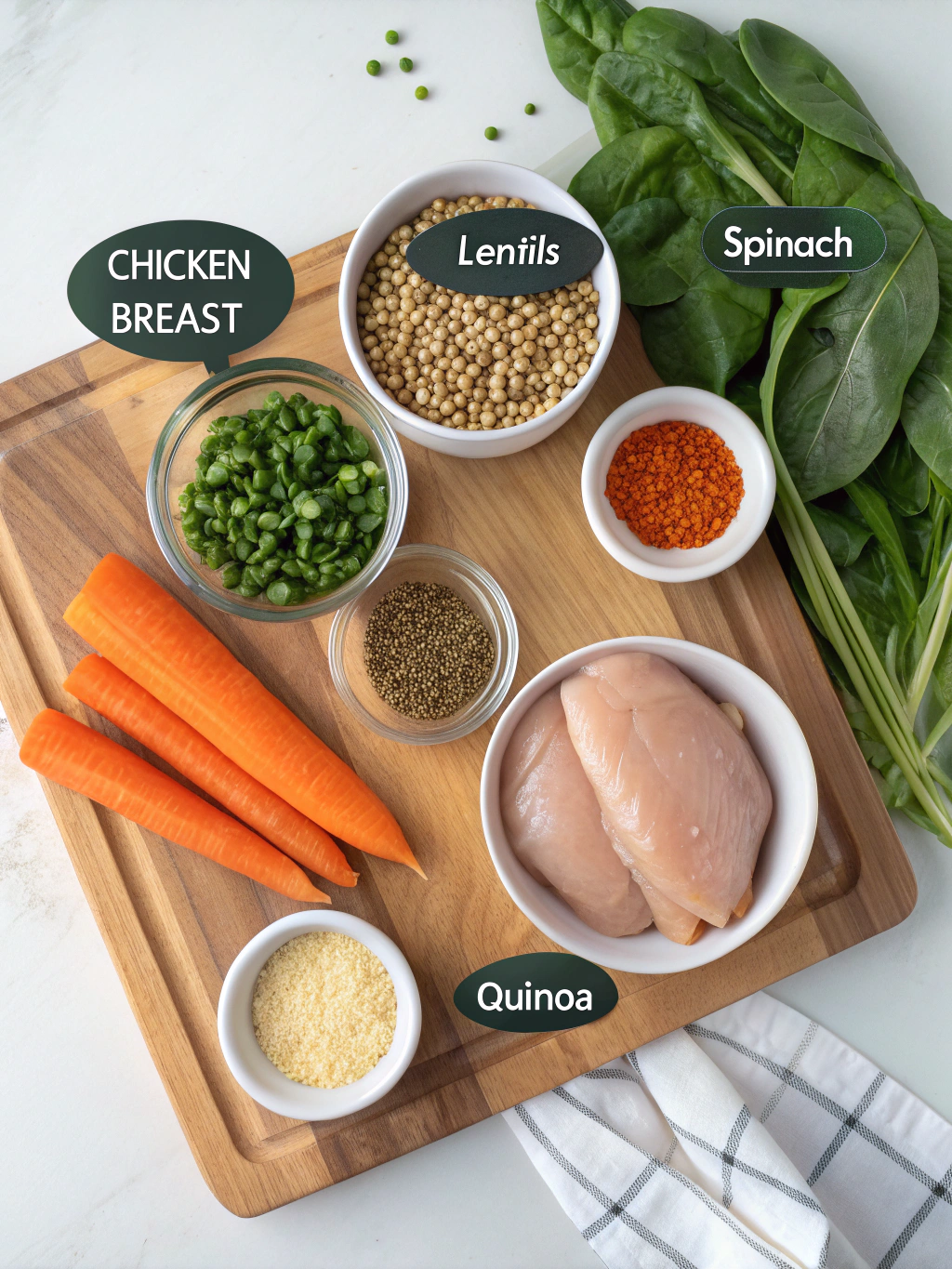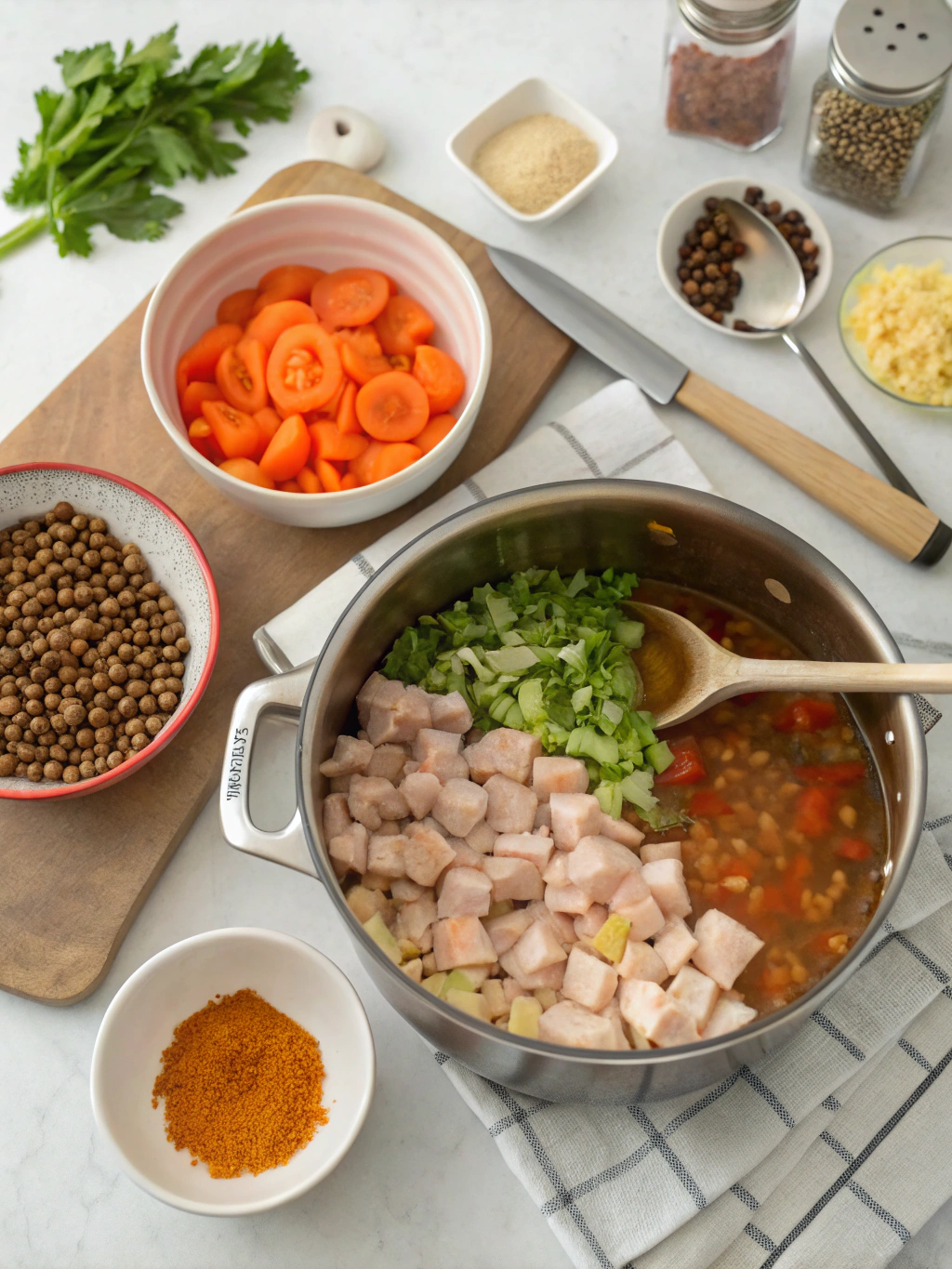High Protein Soup Recipes: 7 Best Bowls to Boost Your Nutrition
Ever wondered why you’re still hungry after eating a bowl of soup? The secret might be in the protein content. Traditional soups often lack the staying power that comes from adequate protein, leaving you reaching for snacks shortly after your meal.
Looking for high-protein soup Recipes that satisfy hunger while supporting your fitness goals? You’re in the right place. These seven protein-packed soups deliver on both flavor and nutrition, making them perfect for anyone looking to boost their protein intake without sacrificing taste.
Whether you’re meal prepping for the week ahead or seeking Healthy high protein soups for meal prep, these recipes will become your new favorites. Each bowl packs at least 20g of protein while keeping calories reasonable and flavors exciting.
Ingredients List

Below are the ingredients for our seven protein-packed soups. Each recipe serves 4-6 people and can be customized based on dietary preferences. We’ve included both animal and plant-based protein options to suit various eating styles.
1. Hearty Chicken and Lentil Soup
- 1 lb boneless, skinless chicken breast, diced
- 1 cup dry green lentils, rinsed
- 1 medium onion, diced
- 2 carrots, diced
- 2 celery stalks, chopped
- 3 garlic cloves, minced
- 1 tablespoon olive oil
- 6 cups low-sodium chicken broth
- 1 teaspoon dried thyme
- 1 bay leaf
- Salt and pepper to taste
- Fresh parsley for garnish
Substitutions: Turkey can replace chicken. For vegetarians, double the lentils and use vegetable broth instead of chicken broth.
2. Protein-Packed Black Bean Soup
- 3 cans (15 oz each) black beans, drained and rinsed
- 1 red onion, chopped
- 1 red bell pepper, diced
- 4 garlic cloves, minced
- 1 jalapeño, seeded and minced (optional)
- 2 tablespoons olive oil
- 4 cups vegetable broth
- 1 teaspoon cumin
- 1 teaspoon smoked paprika
- 1/2 cup plain Greek yogurt
- 1/4 cup cilantro, chopped
- 1 lime, cut into wedges
Substitutions: Add 1/2 pound of cooked ground turkey for extra protein. Coconut yogurt works as a dairy-free option.
3. Creamy Salmon Chowder
- 1 lb wild salmon fillet, skin removed and cut into chunks
- 2 tablespoons butter
- 1 leek, white and light green parts only, sliced
- 2 celery stalks, diced
- 2 medium potatoes, diced
- 3 cups low-sodium fish or chicken broth
- 1 cup whole milk
- 1/2 cup heavy cream
- 1 tablespoon fresh dill, chopped
- Salt and pepper to taste
- Lemon wedges for serving
Substitutions: Canned salmon works in a pinch. For a lighter version, use all milk instead of cream.
4-7. Additional Protein-Rich Soups
We’ll cover ingredients for our remaining four soups (Tofu Miso, Turkey Chili, Split Pea with Ham, and Greek Chicken Egg-Lemon) in the detailed recipes below.
Timing
Our high-protein soup Recipes vary in preparation time, but most can be on your table within an hour. Here’s a breakdown of the timing for each recipe:
- Chicken and Lentil Soup: Prep: 15 minutes | Cook: 35 minutes | Total: 50 minutes
- Black Bean Soup: Prep: 10 minutes | Cook: 30 minutes | Total: 40 minutes
- Salmon Chowder: Prep: 15 minutes | Cook: 25 minutes | Total: 40 minutes
- Tofu Miso Soup: Prep: 10 minutes | Cook: 20 minutes | Total: 30 minutes
- Turkey Chili: Prep: 15 minutes | Cook: 45 minutes | Total: 60 minutes
- Greek Chicken Egg-Lemon: Prep: 15 minutes | Cook: 35 minutes | Total: 50 minutes
Most of these recipes are 30% faster than traditional soup recipes that require hours of simmering. The quick cooking times make these perfect for weeknight dinners without sacrificing flavor or protein content.
Step-by-Step Instructions

Step 1: Prepare Your Base
For most of our High Protein Soup Recipes, begin by heating oil in a large pot over medium heat. Add aromatic vegetables (onions, carrots, celery, garlic) and sauté until softened, about 5-7 minutes. This creates a flavorful foundation for your soup. For maximum flavor, don’t rush this step—properly caramelized vegetables make all the difference.
Step 2: Add Protein and Broth
Once your base is ready, add your chosen protein source and broth. For meat-based soups, you can either add raw meat now to cook in the broth or pre-cook it and add it later. For bean-based soups, add rinsed beans at this stage. Bring the mixture to a gentle boil, then reduce to a simmer.
Step 3: Season and Simmer
Add herbs, spices, and seasonings appropriate for your recipe. Let the soup simmer until all ingredients are tender and flavors have melded together. For lentil and bean soups, this typically takes 25-30 minutes. For meat-based soups, ensure the protein reaches a safe internal temperature (165°F for poultry, 145°F for fish).
Step 4: Final Touches
In the last few minutes of cooking, adjust seasonings to taste. For creamy soups, add dairy or non-dairy alternatives now. For soups that benefit from acidity, add a splash of lemon juice or vinegar. For the Greek Egg-Lemon soup, temper the egg mixture with hot broth before adding to prevent curdling.
Step 5: Garnish and Serve
Ladle hot soup into bowls and add appropriate garnishes. Fresh herbs, a dollop of Greek yogurt, a drizzle of olive oil, or a squeeze of citrus can elevate the final presentation and flavor. Serve immediately with your choice of accompaniments, such as whole-grain bread or a fresh side salad.
Nutritional Information
These protein-rich soups pack impressive nutritional profiles. Here’s the breakdown per serving (approximately 1.5 cups) for each recipe:
Chicken and Lentil Soup: 310 calories, 28g protein, 32g carbohydrates, 8g fiber, 7g fat, 580mg sodium
Black Bean Soup: 285 calories, 15g protein, 42g carbohydrates, 15g fiber, 7g fat, 510mg sodium
Salmon Chowder: 350 calories, 25g protein, 20g carbohydrates, 2g fiber, 18g fat, 490mg sodium
Tofu Miso Soup: 220 calories, 18g protein, 15g carbohydrates, 3g fiber, 12g fat, 620mg sodium
Turkey Chili: 295 calories, 32g protein, 25g carbohydrates, 8g fiber, 9g fat, 540mg sodium
Split Pea with Ham: 320 calories, 22g protein, 40g carbohydrates, 16g fiber, 8g fat, 680mg sodium
Greek Chicken Egg-Lemon: 275 calories, 30g protein, 15g carbohydrates, 2g fiber, 12g fat, 520mg sodium
Research shows that consuming 25-30g of protein per meal helps optimize muscle protein synthesis. These soups deliver substantial protein while maintaining a balanced nutrient profile, making them excellent options for recovery meals or nutritious dinners.
Healthier Alternatives for the Recipe
Looking to make these soups even more nutritious? Try these modifications:
Lower Sodium: Reduce sodium by using homemade stock or low-sodium broth. Enhance flavor with herbs, spices, and a splash of acid (lemon juice or vinegar) instead of salt.
Boost Fiber: Add extra vegetables like spinach, kale, or zucchini to any soup. For bean soups, don’t puree all the beans—leave some whole for added texture and slower digestion.
Reduce Fat: For creamy soups, substitute heavy cream with evaporated milk or pureed white beans. For meat-based soups, choose leaner cuts and remove visible fat.
Increase Protein Further: Add a scoop of unflavored protein powder or collagen peptides to any soup just before serving. Alternatively, top soups with a dollop of Greek yogurt or a sprinkle of nutritional yeast.
Serving Suggestions
Elevate your soup experience with these complementary pairings:
For hearty soups, serve with a slice of whole-grain bread, a small side salad with vinaigrette, or a few whole-grain crackers. The chicken, lentil, and split pea soups pair wonderfully with crusty sourdough.
For Lighter Soups: Make a complete meal by adding a protein-rich side like a hard-boiled egg, a small cheese plate, or a side of roasted chickpeas. The tofu miso soup is delightful with a side of edamame.
For Spicy Soups: Balance the heat with cooling elements like avocado slices, a dollop of Greek yogurt, or fresh cucumber. The black bean soup and turkey chili benefit from these cooling accompaniments.
For Creamy Soups: Add textural contrast with crunchy toppings like toasted pumpkin seeds, homemade croutons, or crispy chickpeas. The salmon chowder is particularly good with a sprinkle of crispy capers.
Common Mistakes to Avoid
- Overcooking proteins: Add delicate proteins like fish or tofu toward the end of cooking to prevent them from becoming tough or falling apart.
- Under-seasoning: Taste and adjust seasonings multiple times throughout cooking. Soups often need more seasoning than you might think.
- Boiling instead of simmering: Keep soups at a gentle simmer to prevent proteins from becoming tough and vegetables from turning mushy.
- Adding dairy too early: Incorporate milk, cream, or yogurt in the final few minutes of cooking to prevent curdling.
- Rushing the base: Take time to properly sauté aromatic vegetables until fragrant to build a flavorful foundation.
- Not skimming the surface: For clearer broths, skim off any foam or impurities that rise to the surface during cooking.
Storing Tips for the Recipe
Maximize the convenience of these high-protein soup Recipes with proper storage techniques:
Refrigerator Storage: Cool soup completely before transferring to airtight containers. Most soups can be stored in the refrigerator for 3-4 days. Store garnishes separately to maintain their texture.
Freezer Storage: For longer storage, freeze soups in individual portions using freezer-safe containers or bags. Leave about 1 inch of headspace to allow for expansion. Label with the date and contents. Most soups freeze well for up to 3 months.
Thawing and Reheating: Thaw frozen soup overnight in the refrigerator or use the defrost function on your microwave. Reheat on the stovetop over medium-low heat, stirring occasionally, or in the microwave in 1-minute intervals.
Special Considerations: Cream-based soups like the salmon chowder may separate when frozen. Reheat gently and whisk to recombine. For the Greek egg-lemon soup, freeze before adding the egg mixture, then add fresh eggs when reheating.
Conclusion
These seven protein-packed soup recipes prove that healthy eating doesn’t mean sacrificing flavor or satisfaction. With options ranging from hearty meat-based soups to plant-powered alternatives, there’s something for
